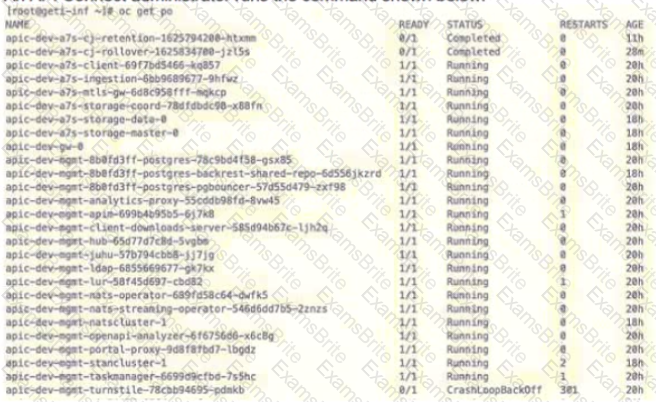
IBM Cloud Pak for Integration V2021.2 Administration
Last Update Jan 14, 2026
Total Questions : 113
We are offering FREE C1000-130 IBM exam questions. All you do is to just go and sign up. Give your details, prepare C1000-130 free exam questions and then go for complete pool of IBM Cloud Pak for Integration V2021.2 Administration test questions that will help you more.



Which Kubernetes resource can be queried to determine if the API Connect op-erator installation has a status of 'succeeded?
When using the Platform Navigator, what permission is required to add users and user groups?
How many Cloud Pak for Integration licenses will the non-production environment cost as compared to the production environment when deploying API Connect. App Connect Enterprise, and MQ?
Which two App Connect resources enable callable flows to be processed between an integration solution in a cluster and an integration server in an on-premise system?
Red Hat OpenShifl GitOps organizes the deployment process around repositories. It always has at least two repositories, an Application repository with the source code and what other repository?
What is one way to obtain the OAuth secret and register a workload to Identity and Access Management?
Users of the Cloud Pak for Integration topology are noticing that the Integration Runtimes page in the platform navigator is displaying the following message: "Some runtimes cannot be created yet-Assuming that the users have the necessary permissions, what might cause this message to be displayed?
Which two OpenShift project names can be used for installing the Cloud Pak for Integration operator?
Which service receives audit data and collects application logs in Cloud Pak Foundational Services?
An administrator is installing Cloud Pak for Integration onto an OpenShift cluster that does not have access to the internet.
How do they provide their ibm-entitlement-key when mirroring images to a portable registry?
If the App Connect Operator is installed in a restricted network, which statement is true?
Where is the initial admin password stored during an installation of IBM Cloud Pak for Integration?
OpenShift supports forwarding cluster logs to which external third-party system?
Which statement describes the Aspera High Speed Transfer Server (HSTS) within IBM Cloud Pak for Integration?
When using the Operations Dashboard, which of the following is supported for encryption of data at rest?
The OpenShift Logging Elasticsearch instance is optimized and tested for short term storage. Approximately how long will it store data for?
OpenShift Pipelines can be used to automate the build of custom images in a CI/CD pipeline and they are based on Tekton.
What type of component is used to create a Pipeline?
Which two authentication types are supported for single sign-on in Founda-tional Services?
Which queue manager includes a pair of pods, one of which is the active queue manager and the other of which is a standby?
An administrator is using the Storage Suite for Cloud Paks entitlement that they received with their Cloud Pak for Integration (CP4I) licenses. The administrator has 200 VPC of CP4I and wants to be licensed to use 8TB of OpenShift Container Storage for 3 years. They have not used or allocated any of their Storage Suite entitlement so far.
What actions must be taken with their Storage Suite entitlement?
An administrator has been given an OpenShift Cluster to install Cloud Pak for Integration.
What can the administrator use to determine if the infrastructure pre-requisites are met by the cluster?
What team Is created as part of the Initial Installation ot Cloud Pak for In-tegration?
What ate the two possible options to upgrade Common Services from the Extended Update Support (EUS) version (3.6.x) to the continuous delivery versions (3.7.x or later)?
When considering storage for a highly available single-resilient queue manager, which statement is true?
An API Conned administrator runs the command shown below:

Given the output of the command, what is the state of the API Connect components?
Which of the following contains sensitive data to be injected when new IBM MO containers are deployed?